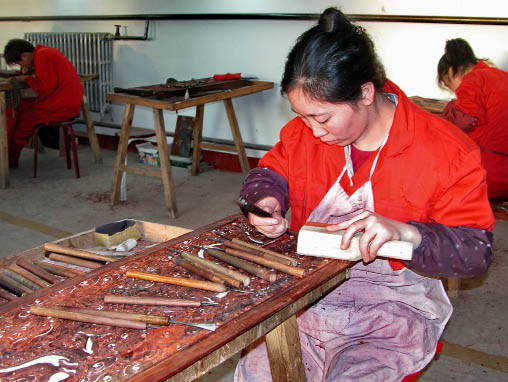| Everything Old Is New Again: Classical Chinese Furniture
By staff reporter LI YUAN
INFLUENCED by policies suppressing the real estate market, overall sales of Chinese furniture declined in 2011. However, market demand for classical Chinese furniture, especially that made of "red wood," a category consisting five rare hardwood species, has seen robust growth. The average price for classical furniture has risen by 50 to 60 percent since last year, and prices for those of scented rosewood, red sandalwood and Dalbergia, the most sought-after "red wood," have increased as much as fourfold. Yang Bo, general manager of Yuanhengli Classical Furniture Company who has been in the business for 13 years, said this year he has witnessed the biggest cost jumps in "red wood" furniture in his entire career.
|
 |
| Hand-carving is still an essential step for sublime "red wood" furniture. |
Ancient Craft, Modern Innovation
Chinese furniture experienced a zenith in the Ming Dynasty (1368-1644) with both designs and functions perfected. In the Qing Dynasty (1644-1911) another development peak introduced striking Manchu features to the repertoire. Ming-style and Qing-style furniture together delineate the general look of China's antique furniture. Nowadays, so-called "classical Chinese furniture" mainly refers to this set of designs. It has been zealously sought after and collected by the wealthy and museums all over the world.
Furniture is mainly made for practical use, however in ancient China it was supposed to have a soul, epitomizing the cultural or even moral height of its designer and the taste of its user. A sublime piece of furniture should be elegant in shape, of first-rate craftsmanship and top-grade timber, and what's more, placed in the right surroundings. The general style of a room or its ornamental accessories can diminish or amplify the charm of the furniture. A traditional Chinese tea set, calligraphy, paintings and various exquisite collectibles can all offset classical pieces.
Classical Chinese furniture not only embodies the aesthetics of the ancient Chinese, but proves irresistibly attractive in modern times. Especially in the last 20 years, people's enthusiasm for classical "red wood" furniture has been rising. Antique furniture made in the Ming and Qing dynasties have been sought out until they became much rarer and therefore more valuable. With the number of genuine antiques shrinking, many people have turned to practical and collection-worthy reproductions.
All of Mr. Chen's free time is devoted to strolls around furniture stores. The 56-year-old is very keen on classical "red wood" furniture and he considers it a better buy, despite the expense much higher than ordinary furniture. "Red wood" furniture is an emblem of its owner's cultural sophistication, and more than that, such durable, environmentally friendly pieces are a good investment. In 2006, Mr. Chen purchased a pair of armchairs made of Dalbergia, a species of the "red wood" group, for RMB 180,000. This year, their price has reached RMB 1.6 million, and the store owner who sold him the chairs offered to buy them back. However, Mr. Chen felt, "Whatever their market price, I'll not sell them because collecting them is my passion."
According to Yang Bo, the target market for "red wood" furniture currently covers a wider age range. Ten years ago, customers aged 50-60 accounted for the majority of buyers, but the growing consumption power of younger generations is fueling a newly emerging market for "red wood" furniture. Furthermore, the market has spread beyond economically developed Beijing, Shanghai, Guangzhou and Shenzhen and extended to second-and third-tier cities.
Zhang Dexiang, vice president of Classical Chinese Furniture Research Institute, regards the flourishing classical Chinese furniture market a result of China's sustained economic development, the strengthening of national confidence and a deepening of people's identification with traditional Chinese culture.
In terms of regions, the carving crafts of classical Chinese furniture can be divided into four schools – Beijing, Suzhou, Guangzhou and Shanxi. However, currently it seems that divisions among them have blurred and the styles of different schools are being blended. There are over 300 craftsmen from all over the country working in Yang's factory and each region has its own special merits. Craftsmen from Hebei are mostly adept at carving royal-court-styled dragons and phoenixes; artisans from Dongyang of Zhejiang Province are the most skilled at carving flowers, birds, fishes and insects, popular subjects in traditional Chinese painting; when it comes to three-dimensional work, the craftsmen of Fujian are the masters.
"Artisans have handed down their skills for generations. Most of them don't have much schooling, but can create works that fetch higher prices than some mainstream painters. What distinguishes them from mediocre cabinet makers is the expressiveness, vividness and exalted spirit of their works that underlies the charm of their natural landscapes, the dynamism of their animals and richness of their character portrayal – an eye for detail that cannot be learned from books," said Yang Bo.
|
